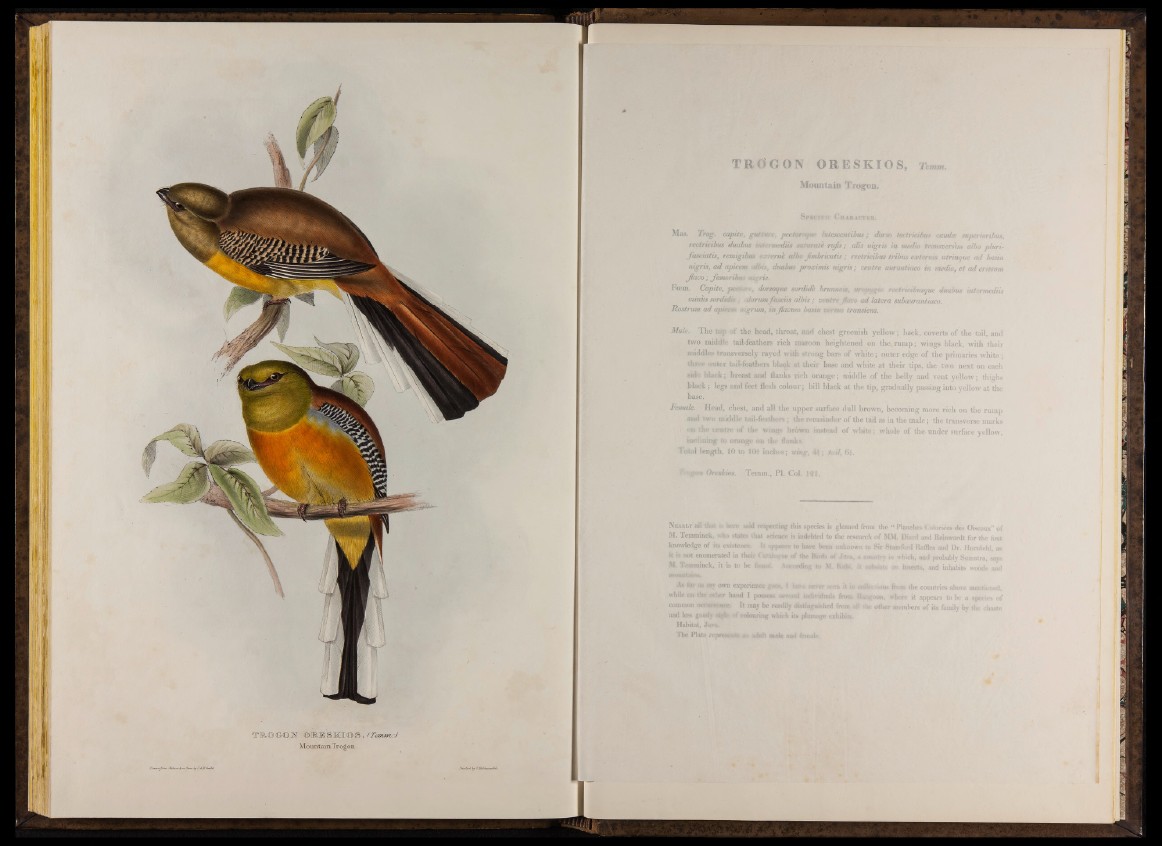
T R Ü <&©ST O ' I E S H O S î rnmmy)
Mountain Trogon,
JVini*t> 1y CBUUhwhM/.
T R dGON ORESKIOS , Ttmm.
Mountain Trog’on.
>Sp2ict!•?<:: C h a r a c t e r .
Mas. Trog. capite, guttt&e, pectoreqnc lutescontibus; dorso tectricibus caudai superioribus,
rectricibus duabus miermediis saturate, m/is; alis nigris in medio transverstm cdbo pluri-
fasciatis, remigibm t-.viernl cdbo fmbricatis; rectricibus tribus externis utrinque ad basin
nigris, ad apicem tdbis, duabus proximis nigris; ventre aurantiaco in medio, et ad crissum
Jldvo ; jemorihus ntgris.
Foem. Capite, peckwe, dorsoque sordide hmnneis, unqygto recti icibusque duabus intermediis
minus sordid* . d a r um f asciis albis ; ventre J kvo ad latera subaurantiaco.
Rostrum ad apicem nigrum, inflavum basin versus transient.
Male. The top of the head, throat, and chest greenish yellow; back, coverts of the tail, and
two middle tail-feathers rich maroon heightened on the,rump; wings black, with their
middles transversely rayed with strong bars of white; outer edge of the primaries white;
thwsp outer tail-leathers black at their base and white at their tips, the two next on each
side black; breast and flanks rich orange; middle of the belly and vent yellow; thighs
black; legs and feet flesh colour; bill black at the tip, gradually passing into yellow at the
base.
Female. Head, chest, and all the upper surface dull brown, becoming more rich on the rump
and two middle tail-feathers ; the remainder of the tail as in the male; the transverse marks
*m the centre of the wings brown instead of white; whole of the-under surface yellow,
tnebning to orange on the flanks.
Total length, 10 to 1(H inches; wing, ; tail, 6f.
Tmgtm Oreskios. Temm., PI. Col. 121.
N e a r l y ail t&at b here said respecting this species is gleaned from the “ Planches Coloriées des Oiseaux” o f
M. Temminck, who stages that science is indebted to the research of MM. Diard and Reinwardt for thé first
knowledge of its existence. It appears to have been unknown to Sir Stamford Raffles and Dr. Horafield, as
it is not enumerated in their (andosue of the Bird* of Jsva, conntry it» which, and probably Sumatra, says
M- Temminck, it is to be fcwwrî According to M. Knfei. ; on insects, and inhabits woods ami
DKMStMA
As im as my own experience goes, 1 hare never *een it m fions fro« the countries above mentioned,
while oa the other band I possess several individuals from Rangoon, where it appears to be a species o f
common oeewweee. It may be readily distinguished from s$ *he other members of its family by the chaste
and less gaudy styk- of colouring which its plumage exhibits.
Habitat, Java.
The Plate represents sn UWt male and female.